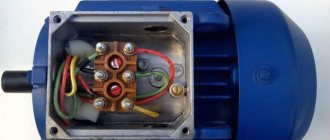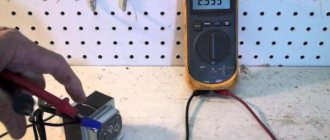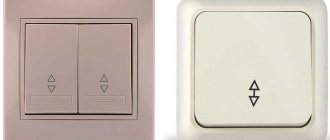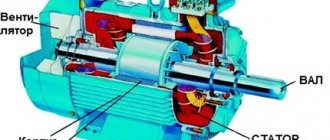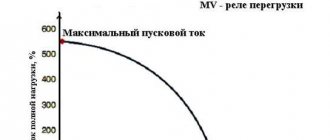Winding connection options
An asynchronous three-phase electric motor has three windings - for each phase separately - going into the stator slots. However, for the generation of electromotive force and, as a result, rotation of the rotor, they must be connected to each other. It is important to know the connection option for a specific motor. Since this will help you choose the right scheme for connecting it to the 220V network.
Each of the three windings corresponds to its own phase and has both a beginning and an end. In this case, the inputs and outputs are designated by the corresponding letters and numbers:
Range of engines produced during the Soviet Union:
- The first phase is C1-C4.
- Second phase C2-C5.
- Third phase C3-C6.
Designations of modern engines:
- First phase U1-U2.
- Second phase V1-V2.
- Third phase W1-W2.
Connecting the winding of a three-phase motor Source autogear.ru
There are two main circuits for connecting the windings in the type of motor under consideration:
- Star.
All winding outputs are connected to one point, and the inputs, respectively, to the phases. The schematic representation of this method looks like a star. With this method, a 220V phase is applied to each individual core, and a linear 380V is applied to two consecutive cores.
The main advantage of this scheme is the application of linear current to two wires simultaneously, which significantly reduces inrush currents and allows the rotor to perform a soft start. The downside is lower power due to weak currents in the winding.
- Triangle.
The input of the previous winding is connected to the output of the next one - and so on in a circle. As a result, the diagram resembles a triangle. At a linear voltage of 380V, the currents in the winding will reach a significantly higher value than in the above option. This will make it possible for the motor to exert a significantly greater amount of force. The disadvantage of the circuit is that stronger inrush currents can lead to network overload.
Triangle diagram Source ytimg.com
Good to know! To obtain the advantages of the first and avoid the disadvantages of the second circuit, the connection of the 380 V electric motor and its subsequent acceleration is carried out on the “star”, and then it is automatically switched to the “delta”.
Connecting a squirrel-cage motor to a three-phase network
The most effective and frequently used methods of connecting an asynchronous motor to a three-phase network are the so-called star and delta.
The squirrel-cage motor design has only six winding contacts - three on each. In order to connect an asynchronous motor with a star, it is necessary to connect the ends of the windings in one place, like the rays of a star. It is noteworthy that in such a circuit the voltage at the beginning of the windings is 380 V, and in the section of the circuit running between their connection and the point where the phases are connected - 220 V. The ability to turn on the engine using this method is indicated on its tag with the symbol Y.
The main advantage of this circuit is that it prevents the occurrence of current overloads on the electric motor, provided that a four-pole circuit breaker is used. The car starts smoothly, without jerking. The disadvantage of the circuit is that the reduced voltage on each of the windings does not allow the engine to develop maximum power.
star connection diagram
If an electric motor with a squirrel-cage rotor was connected in a star configuration, this can be seen by the common jumper at the ends of the windings.
Asynchronous motor, star assembly
To ensure the maximum operating power of a three-phase electric motor, it is connected to the network in a triangle. In this circuit, the stator windings are connected to each other according to the end-to-end principle. When powered from a three-phase network, there is no need to connect to the working zero. The voltage in the sections of the circuit between the terminals will be 380 V. The symbol ∆ is displayed on the nameplate of a motor suitable for connecting triangles. Sometimes the manufacturer even indicates the rated power when using a particular circuit.
triangle connection diagram
The main disadvantage of the triangle is that the starting currents are too large, which sometimes overload the wiring and damage it. As an optimal solution, a combined circuit is sometimes created in which the start and speed increase occurs at the “star”, and then the windings are switched to the “triangle”.
Definition of connection diagram
Before choosing one or another scheme for connecting a motor to 220 V, it is necessary to determine what the connection diagram for its winding is and at what rating it can generally be operated. To do this you need:
- Find and study the technical table on the engine. characteristics .
The information field contains all the important information - designation of the type of connection ∆ - triangle or star - Y , power, number of revolutions, voltage (220 or 380, or 220/380) and the possibility of connecting according to a specific circuit.
- Open the terminal box and verify in practice that the assembled circuit is correct.
The beginning and end of each winding is signed in accordance with the above alphanumeric nomenclature. The user remains to study the connection diagram using jumpers: according to what scheme the connection is made - star or triangle.
Note! If the nameplate (table with information) indicates the Y and only 380V, then when it is connected in a triangle, the winding will burn out. Only professional electricians can upgrade such a 220V motor. Therefore, there is no reason to modify it, especially since today there are many copies that can operate alternatively - both 220 and 380 volts.
Opening the terminal box Source pikabu.ru
See also: Catalog of companies that specialize in electrical work
Connection with wound rotor
Asynchronous electric motors with a wound rotor have high starting and control characteristics, due to which they are used in high-power machines and low-power devices. Structurally, this asynchronous motor differs from a conventional three-phase motor in that the rotor has its own three-phase winding with shifted coils.
To connect electric motors with a wound rotor, the star and delta circuits described above are used (for 380 V and 220 V networks, respectively). It is worth noting that only one circuit specified in the passport can be used for a particular engine. Failure to comply with this requirement may result in engine burnout.
The connection of the windings in the terminal box is made in the same way as in the diagrams from the previous method. The change in performance characteristics is also natural: the triangle produces almost one and a half times more power, and the star, in turn, operates and controls more smoothly.
Unlike models with a squirrel-cage rotor, an asynchronous motor with a three-phase rotor has a more complex design, but this allows for improved starting characteristics and smooth rotation control. Such machines are used in equipment that requires speed control and is started under load, for example, in crane mechanisms.
Connection methods for 220V
To connect a three-phase asynchronous electric motor to a 220-volt network, there are several proven methods:
- With capacitor.
- Without capacitor.
- With reverse.
- Combined star-delta circuit.
Let's look at them in more detail.
Important! When connecting a 380-volt electric motor to a 220-volt network, you need to be prepared to reduce its power to 70% of the factory value. However, in everyday conditions this is quite acceptable and will not affect the performance in any way.
Connecting a 380 V motor to 220 V Source ytimg.com
With capacitor
The most popular and affordable way to initiate 380 volt motors from a 220 V network is a circuit using a capacitor. Its role is to create a phase shift in the windings relative to each other in order to form a rotating magnetic field. If there are three phases, this phenomenon occurs by itself - only one will not force the rotor to rotate. Therefore, the optimal method for connecting an electric motor with 4 wires on one phase is to use a starting winding, in addition to the main winding, in 220V electric motors.
For the 380 V modification, two connection options with a capacitor are possible:
- With working capacitor Cp .
- And parallel connected working Cp and starting capacitor Sp .
In the second case, the engine starts more smoothly and safely. Sp module turns on for a short period of time and turns off as the rotor reaches the required speed. The choice of starting option is largely determined by the degree of rotor load during starting. So, if the start occurs without force, only Cp , and if under load, without free rotation, the presence of Cn .
Connecting a motor with capacitors Source blogspot.com
Connection to a single-phase network
A three-phase unit can be successfully connected to a single-phase network. But it is worth considering that with a circuit called “star”, the power of the unit will not exceed half of its rated power. To increase this figure, it is necessary to provide a triangle connection. In this case, only a 30% drop in power can be achieved. There is no need to be afraid, because in a 220-volt network it is impossible for a critical voltage to arise that would damage the motor windings.
Useful tips
Some useful tips on how to connect a 3-wire motor to avoid problems during operation:
- Before starting work, it is recommended to test the engine at idle, if it is functioning properly, then under load.
- If the case becomes very hot, even without load, it is necessary to reduce the capacity of the working capacitor.
- If after starting the motor just hums, but does not rotate the shaft, then you can set it to start manually - by turning the shaft. Next, you can increase the capacity of the starting capacitor.
- When stopping the engine under operating load, the capacity of the working capacitor should be increased.
Helpful information! It is possible to correctly calculate the capacitance of the capacitor only taking into account the power rating of the motor. If there is underload, overheating will occur and the capacity will need to be reduced.
Delta connection
The “triangle” circuit differs from the previous one in that the windings are connected in series. Then the end of the first winding is connected to the beginning of the second, the end of which is connected to the beginning of the third, and the output of which is connected to the beginning of the first.
The advantage of this method is that it ensures maximum power. But when starting the engine, high starting currents are generated, which can lead to the destruction of insulation. Therefore, it is not recommended to apply high voltage.
The delta connection is used to connect a single-phase motor to a single-phase 127 or 220 Volt network. It is also used for three-phase electric motors with two rated voltages when connected to a single-phase network (only to a lower value):
- Motor 220 380 to a network with a voltage of 220 Volts;
- Motor 127 220V to a network with a voltage of 127 units.
Attention! There are three-phase electrical networks: 600, 380, 220 and 127 Volts. But household ones are classified only with a voltage of 380. And 220 in everyday life refers to single-phase lines. Therefore, the most widespread are 220/380V motors, which can be connected both in the city and in a private home.
From a technical point of view, the delta circuit is also suitable for a high rated voltage. But due to high inrush currents, this is impractical and very dangerous: the insulation will burn out from the heat generated by the winding.
Briefly about the main thing
You can connect a 380 to 220 volt electric motor in 4 main ways:
- With capacitor.
- Without capacitor.
- With reverse.
- Star-delta design.
Before starting connection work, it is necessary to determine and verify how the winding is connected in the terminal box, and also find out the necessary characteristics from the technical table. You can perform electrical work if you have experience, but it is better to entrust it to professionals with the appropriate permit.
Ratings 0
Single-phase and three-phase
In order to correctly understand the subject of discussion, which explains the connection of a 380 to 220 volt engine, it is necessary to understand what the fundamental difference between such units is. All three-phase motors are asynchronous. This means that the phases in it are connected with some offset. Structurally, the engine consists of a housing in which a static part is placed that does not rotate, it is called a stator. There is also a rotating element called a rotor. The rotor is located inside the stator. Three-phase voltage is supplied to the stator, each phase is 220 volts. After this, an electromagnetic field is formed. Due to the fact that the phases are in angular displacement, an electromotive force appears. It forces the rotor, which is located in the magnetic field of the stator, to rotate.
Note! Voltage is supplied to the windings of a three-phase motor through a type of connection that is made in the shape of a star or triangle.
Single-phase asynchronous units have a slightly different type of connection, since they are powered by a 220 volt network. It only has two wires. One is called phase, and the second is called zero. To start, the motor needs to have only one winding to which the phase is connected. But just one will not be enough for the starting impulse. Therefore, there is also a winding that is activated during start-up. For it to fulfill its role, it can be connected through a capacitor, which happens most often, or short-circuited.
Connection diagram for three-phase motors in a single-phase network
For safe and correct operation of a three-phase asynchronous motor from a household network, it is necessary to use a capacitor. Moreover, its capacity should depend on the number of engine revolutions.
In practical implementation, this device is quite problematic to manufacture. To solve this problem, two-stage motor control is used. Thus, at the moment of start-up, two capacitors work:
- launcher (Sp);
- worker (Wed).
After the engine reaches operating speed, the starting capacitor is turned off.
Let's consider a diagram for connecting a motor using two capacitors.
This option assumes the use of a motor in a 220/380V network. Diagram: Designations: Ср – working capacitor; Sp – starting capacitor; P1 – packet switch.
When the packet switch P1 is turned on, contacts P1.1 and P1.2 close. At this moment you need to press the “Acceleration” button. When the engine reaches operating speed, the button is released. The engine is reversed by switching toggle switch SA1.
Important: correctly calculate the capacity of the working capacitor.
Let's consider several formulas for connecting windings using different methods:
- For the star method. Formula: Wed = 2800*(I/U); where Cp is the capacitance of the working capacitor (μF), I is the current consumed by the electric motor in (A), and the network voltage (V).
- For the triangle method. Formula: Avg = 4800*(I/U); where Cp is the capacitance of the working capacitor (μF), I is the current consumed by the electric motor in (A), and the network voltage (V).
For any switching method, the current consumed by the electric motor is calculated. Formula: I = P/(1.73Uŋ*cosϕ); where P is the engine power in W, indicated in its passport; ŋ – efficiency; cosϕ - power factor; U is the network voltage.
In this scheme, the capacitance of the starting capacitor Cn is selected 2-2.5 times higher than the capacitance of the working capacitor. In this case, all capacitors must be designed for a voltage exceeding the network voltage by 1.5 times.
INFORMATION: For 220V household networks, capacitors such as MBGO, MBPG, MBGCh with an operating voltage of 500V and above are well suited. For short-term connection, capacitors K50-3, EGC-M, KE-2 are used as starting capacitors. In this case, their operating voltage must be at least 450 V. For greater reliability, electrolytic capacitors are connected in series, connecting their negative leads together, and shunted with diodes


